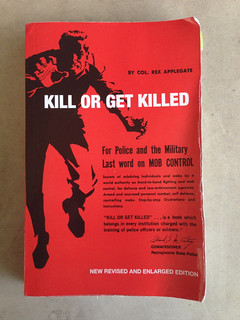
Col. Applegate was in charge of training a lot of SAS and other infantry units during WWII. At the time, he was the guy training the people that “killed more people than cancer.” I’ve read a couple of his books/training manuals while I was in the Marine Corps. Ironically, Col. Applegate was in the US Army and his books became the basis for a lot of Marine Corps manuals while Col. Cooper was a US Marine and his books and writings became the basis for a lot of Army manuals. Just a weird history quirk. I’ve read books by both men and they both have something to bring to the table.
This book, “Kill or Get Killed” by Applegate was a book written in the early 1960’s, revised in the early 1970’s and was the basis tons of people created training around in the 1970’s and 80’s. Applegate gets little credit by most people but was the first to think of lots of things, like the house of horrors. A crazy shoot house where everything is hard to see, hit, and maneuver in. A lot of people have created shoot houses to simulate the disorientation of actual combat, but Applegate might have been the first during WWII. In this book, he describes a house he built, how to use it, and how to build simple targets to use in it. He also talks a lot about how to create and build you own.
This was a good book, but I would only recommend people that are trainers or unit leaders to take the time to read it. At over 400 pages there is a lot of knowledge, but a lot of it is directed at leading people, training others, and on thinking of the big picture.
The first half of the book is on hand-to-hand, knife, and individual firearms techniques. The book gets a little slow about describing all of the techniques because Applegate is trying to write to people that don’t have a basic understanding of techniques, but I don’t think I would have understood half of it without having the knowledge of other fighting techniques first.
The section on combat shooting of the handgun was great, and a must read for anyone that wants to train other shooters in self defense or combat handgun use. He gave me a lot of tips and tricks to help students learn and some new things to think about. Col. Applegate believes in point shooting a handgun (he calls it instinctive shooting), and describes shooting a handgun without the use of sights. So nothing is really new, it just comes around again. Right now, the fight is on again between trainers and shooters of point shooting versus sighted shooting. In the late 1990’s, I thought the question was settled on sighted shooting, but now that it’s open again, it brings new light to an old technique.
Sections on controlling prisoners and intermediate weapons are a little outdated but the ideas are still the same and controlling the persons in custody are still the same. He also gives some good advice about searching people by yourself and using the other person’s clothing to impede them.
The final chapters in the book where added later and this was the first time I’ve seen these thoughts, they were on riot control. I was trained in riot control while a Marine. The techniques and thoughts in this were awesome. The entire chapter is 70 bullet points with a sentence or two of explanation on tips for employing a riot control unit. If you are part of a riot team, or might have to be called to put down a riot in your law enforcement or military duties, you should read the last four chapters of this book. Even with the extensive training I have from the Marine Corps and Police Academy, I learned a lot from these four chapters. Keep an open mind as some of the equipment talked about is out dated (like a transistor radio), but the ideas are still the same. I wish I had read this book when I was part of a riot control team in the Marine Corps.
Overall, this book was long and wordy for a civilian, the average police officer or soldier. The subjects weren’t covered well enough for a beginner. I would suggest this book for a team leader or trainer, and riot control teams should read the last four chapters. Everyone else, I think there are more efficient was to spend your time.
Stay Safe,
Ben
If you want to take a good deal from this piece of writing then you have
to apply these techniques to your won website.
This book was written by my.grandfather the col.may he rest in piece